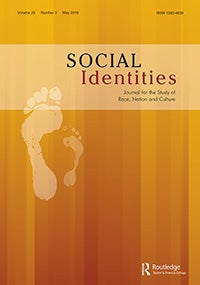Journals

Social Identities – Special Issue: Mixed Race in Southeast Asia and Australasia: Race, Nation, Identity and Belonging (Vol. 25, Issue 3)
| Author | : | ROCHA Zarine L., FOZDAR Farida, ACEDERA Kristel Anne & YEOH Brenda S.A. |
| Publication Date | : | Sep / 2018 |
| Publisher | : | Taylor & Francis Online |
Visions of a cosmopolitan, melting pot world, where races and cultures are blended and intermixed to produce hybrid cultures and ‘coffee coloured people’, are common in both popular culture and academic theorizing. Despite the theoretical messiness of the concept of race, ‘mixed race’ itself is an increasingly popular area of study in the social sciences, as evidenced by the growing field of critical mixed race studies (Daniel, Kina, Dariotis, & Fojas, 2014; Parker & Song, 2001). Issues around mixedness and belonging also transcend the fields of ethnic and racial studies, with important implications for wider studies of identity, community, and nation-building. Mixed identities have become more common in some parts of the world, with increasing numbers of people identifying as mixed and seeking or creating forms of belonging to encompass this mixedness. This trend is further seen in the growing interest in DNA testing to determine the global scale of one’s ancestry (Omi, 2010; Spickard, 2015), and the online mixed community, which ranges from sharing academic research to social network building (such as www.mix-d.org; www.intermix.org.uk; mixedrootsstories.com; www.mixedsingle.com; www.mixedracestudies.org). However, such identity construction often remains on the margins of much theory and policy-making, and needs both theoretically and practically, to not just acknowledge, but provide space for more complex identities.
Previously, the majority of research has focused on ‘Western’ multicultural societies, particularly in Europe and North America, often overlooking the vast diversities of cultures, ethnicities, languages, and histories of mixing in other parts of the world. This has begun to change in recent years, notably in collections such as Global Mixed Race (King-O’Riain, Small, Mahtani, Song, & Spickard, 2014), and International Perspectives on Racial and Ethnic Mixedness and Mixing (Edwards, Ali, Caballero, & Song, 2012). However, both volumes lack contributions on mixed race in Asia, and the focus has been on individual identities rather than state frameworks and cultural formations, leaving a significant proportion of the world’s population relatively unexamined. Following on from this, new international research has begun to emerge in Asia and the Pacific, focusing specifically and in more depth on the local and regional experiences and histories of mixedness and cultural exchange (McGavin & Fozdar, 2016; Rocha & Fozdar, 2017). The newly growing literature indicates that while studying mixed race in any context is challenging as it often raises questions about the continued power and recognition of the discredited concept of race, there are region-specific, under-researched issues and puzzles in Asia and Australasia which add particular layers of complexity and urgency to the work.
This special issue aims to take this research further, giving much needed attention to a context where the social construction of race remains an undeniable, if often taken for granted, force in everyday life, both at macro and micro levels. Racial, ethnic and cultural mixing has a long history in both Asia and Australasia, being inextricably linked with national stories of migration, indigeneity, diaspora, colonialism and nation- building. Thus, narratives, experiences, and understandings of mixed race have developed in vastly different ways. From established named identities such as Eurasians in Malaysia and Singapore, to forbidden mixes such as mixed Aboriginal/white children in Australia, individuals of mixed heritage have had diverse experiences across both regions. These experiences have been shaped by a wide range of historical circumstances: histories of forced and/or voluntary migrations, political contexts (monarchies, democracies, colonial, and postcolonial states, authoritarian dynasties), hierarchies of race and culture, and varying emphases on ‘racial purity’ as a desirable, or attainable, trait. This special issue adds important new dimensions to previous research by highlighting new country contexts and drawing out the intersections between personal mixed identities, histories of classification, representations of mixedness, and changing policy frameworks in diverse nation-states. It provides a broader outlook, positioning understandings of mixed race on comparative and transnational scales, and illustrating the richness of research on mixedness in Asia and Australasia.

